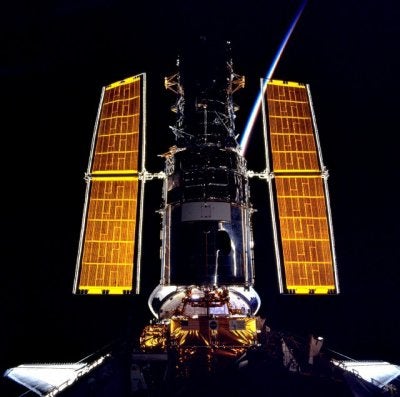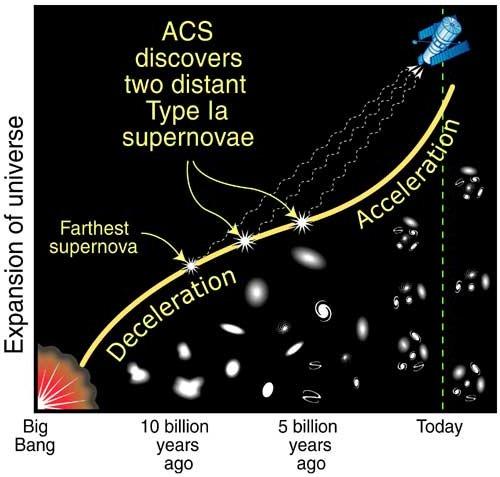Cosmologists are a rare breed of detectives, trying to piece together the shadowy tale of the universe’s evolution. Their clues lurk in the farthest reaches of outer space and in the remotest times of the distant past. Now Adam Riess of the Space Telescope Science Institute in Baltimore has detected crucial new evidence, bringing us one step closer to understanding the history and fate of the universe.
Using the Hubble Space Telescope, Riess and his team measured light bursting from a handful of type Ia supernovae whose distances correspond to nearly three-quarters back toward the beginning of time. There they found clear evidence of the deceleration that occurred before dark energy took the reigns roughly five billion years ago and began accelerating the universe’s expansion.
The scientific community has eagerly awaited these results since 1998, when news that the universe is expanding faster and faster had come as an astonishing twist in the cosmological plot. Two teams of observers — the Supernova Cosmology Project and the High-Z Supernovae Search Team — had been studying type Ia supernovae to determine the expansion rate of the universe. By comparing these supernovae’s intrinsic brightness to their apparent brightness, astronomers can determine their distance; their redshift then reveals how greatly space has expanded in the time it took for their light to reach us.
The teams found their supernovae to be dimmer than expected, which meant that the universe’s expansion is currently accelerating. Their results, combined with evidence from the cosmic microwave background radiation, forced scientists to conclude that some repulsive form of energy makes up over 70% of the contents of the universe.
Riess, who was a member of the High-Z Supernovae Search Team, has done just that with the Hubble Higher-z Supernova Search Team. Using the Hubble Space Telescope, the team found six of the seven most distant supernovae found to date. “We got the first really significant sample of supernovae that were at such high redshift you could see the slowing down of the expansion of the universe preceding the speeding up,” Riess says.
Knowing when the universe switched from deceleration to acceleration will help narrow down the now-exorbitant number of theoretical models hoping to explain the existence of dark energy.
The finding also assures astronomers that the observed acceleration is real and not due to something prosaic like cosmic dust. If dust was the culprit, the dimming of supernovae would increase the farther back you look. But the distant supernovae Riess and his team observed are brighter than expected, confirming that gravity applied the brakes on cosmic expansion before dark energy let a heavy foot down on the gas. “This is one way we can be sure that we’re not being fooled,” says Dartmouth College physicist Robert Caldwell.
The detective work is far from over, but at least cosmologists know they’re hot on the trail of the elusive dark energy. “We still have a long way to go in understanding the onset and evolution of acceleration,” says University of Chicago physicist Sean Carroll. “A lot of effort will be going into this problem — it’s by far the biggest puzzle in cosmology today.”











